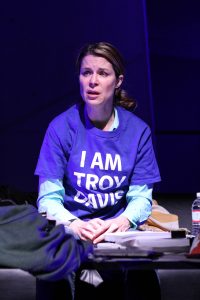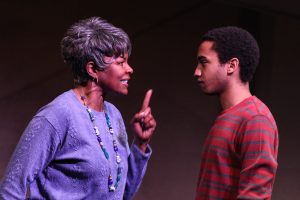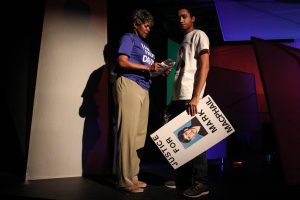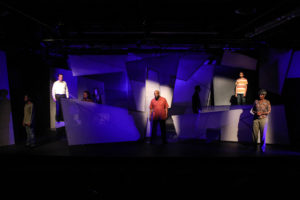‘Beyond a Reasonable Doubt’: A powerful deconstruction of absolute truth

By Tonesa Jones
“One of the dangers of doing a play like this is you don’t want it to be a living newspaper.”
Actress Terry Henry’s observation of the difficulty producing “Beyond a Reasonable Doubt: The Troy Davis Project,” speaks to the complexity of the story Lee Nowell brought to the stage. This play tackles the complicated case of Troy Anthony Davis, an African-American man executed by the state of Georgia in 2011 for the murder of police officer Mark MacPhail. Until his execution, Davis maintained his innocence and petitioned the courts after seven of nine eyewitnesses recanted their statements. Because of the nonlinear structure of the play and the amount of information it includes, the immediate challenge of this production was presenting a cohesive narrative that challenges viewers’ perceptions of truth and justice while also showing believable, human characters.

This play rises to the challenge by filtering the complexities of this case through the intimate space of a living room. The most interesting aspect of this production is that the opening act changes depending on which night the viewer attends. Show “A” begins with Mary (Terry Henry), a grandmother who actively participates in the grassroots movement to stay the execution of Troy Davis. Her grandson Curtis (Stephen Ruffin) firmly believes Troy Davis is guilty. This internal conflict between Mary and Curtis over the ethics of the death penalty and the bias in the justice system towards people of color is interspersed with documented statements from witnesses who recanted or doubted their initial statements to the police. This approach, along with powerhouse performances by Henry and Ruffin, nuances the discussion occurring between Mary and Curtis, allowing viewers to sympathize with both characters even if they do not agree with the opinions these characters have.
The second act features Alison, a burned-out social activist (Lane Carlock), and her lawyer husband Tony (John Benzinger). This act presents the other side of the story and how the legal system convicted Troy Davis. Alison’s story becomes a careful critique of soundbite culture and how facts presented in the court of public opinion do not fully represent of the facts presented in a courtroom.

The set and story structure deconstruct this case along with viewers’ perspection of the truth. Surrounding the living room set are a series of geometric white panels that show facts and witness statements like a series of mirror shards. The set design reflects the intent of the play by showing that in spite of being presented the same facts, viewers do not come to the same conclusion and often view each other as though occupying different worlds.


“Beyond a Reasonable Doubt: The Troy Davis Project” is a conversation starter that challenges viewers to question what they view as absolute truth. In this age of divisive rhetoric and eroded political discourse, this play is a refreshing space that encourages people on opposites sides of a debate to engage in meaningful dialogue. This play is running now through Sunday, May 1 at Synchronicity Theatre. For more information about this production, click here.




























